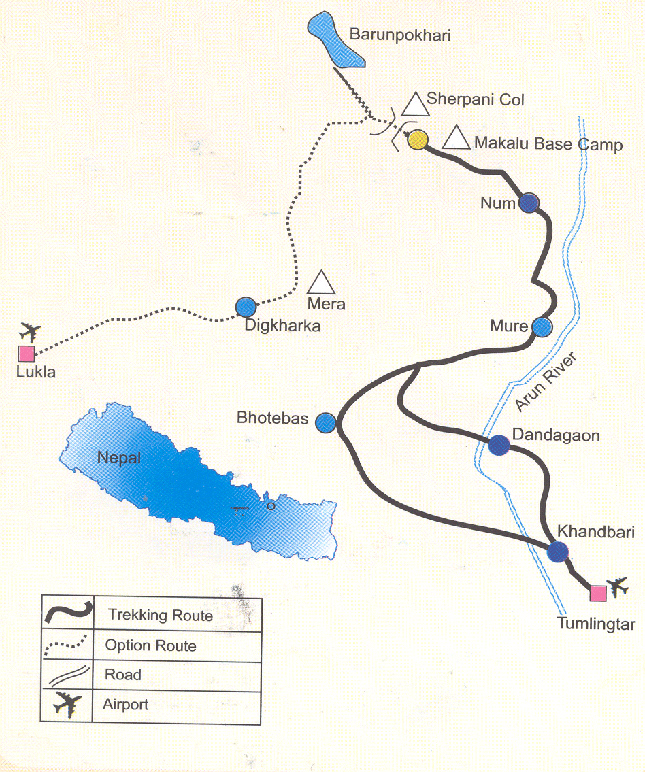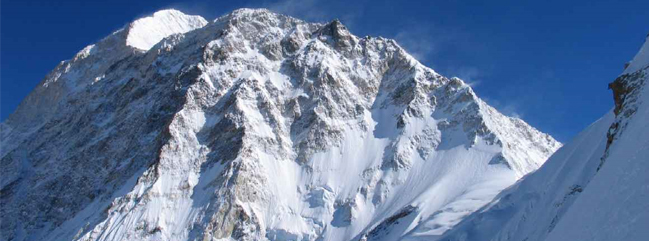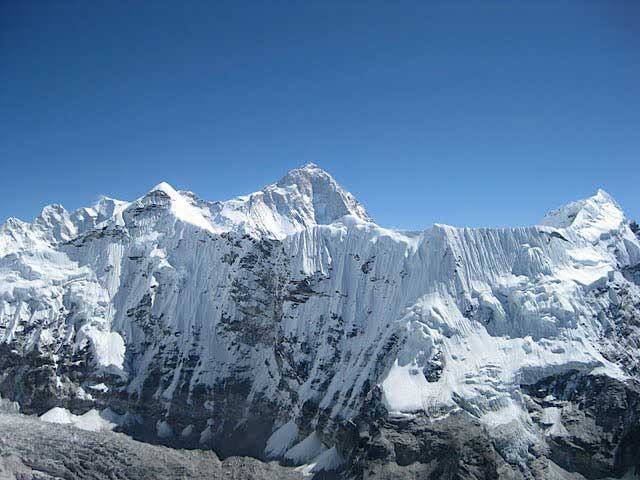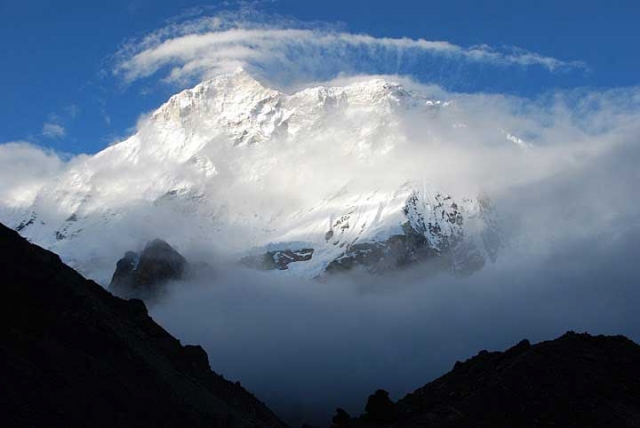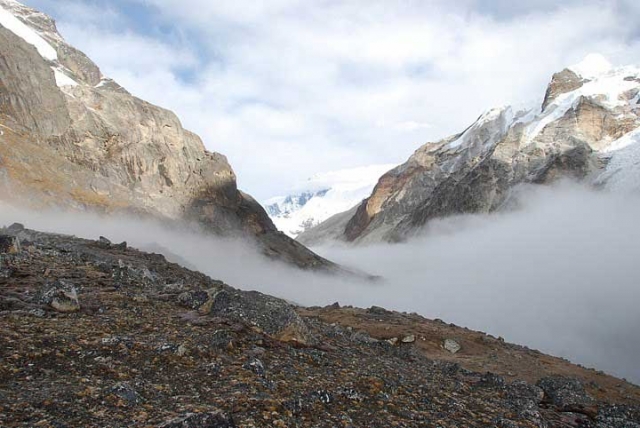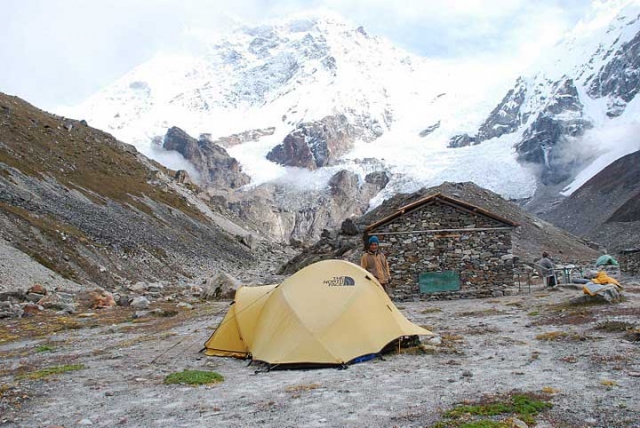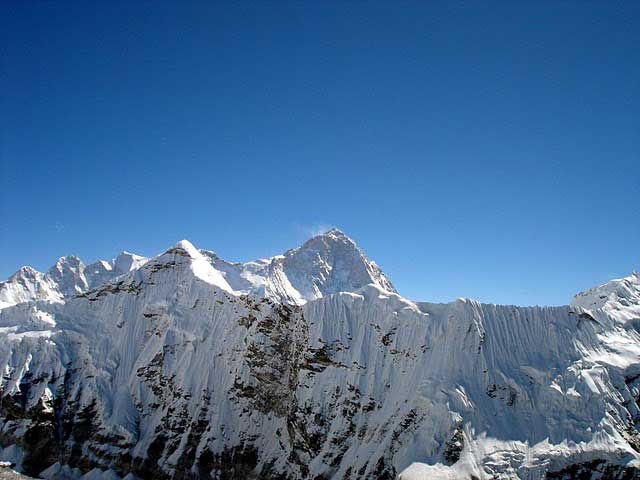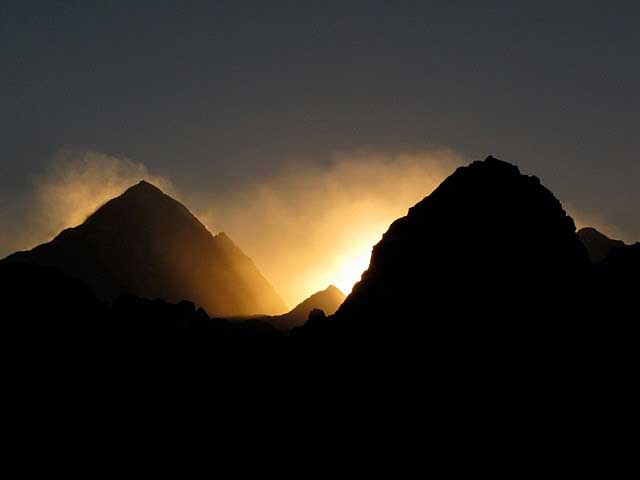Makalu Expedition was first climbed by a French party in 1955. The peak was first mapped and photographed from the Tibetan side by the 1921 British Everest reconnaissance. Hillary and Shipton photographed mount Makalu on the 1951 Everest reconnaissance. Hillary and others approached the peak a year later after the failure of their mount Cho Oyu expedition. The first attempt on mount Makalu was in 1954 by a US team, mostly from California, who trekked all the way from the Indian border near Biratnagar. At the same time a British team approached the mountain, but this expedition was abandoned when Hillary became seriously ill and had to be evacuated. In the autumn of 1954 a French team attempted the peak. In the following spring, successfully ascents were made by three teams of French climbers on successive days. The Japanese climbed mount Makalu in 1970, another French team climbed it in 1971 and a Yugoslav expedition reached the summit in 1975.
Makalu West Face
It is very adventurous route to climb because it is a little bit dangerous as well. The 5 attempts were made before climbing this Mount Makalu Mountain; then only it was succeeded in the final. The West Face was successfully scaled in 1997. The Russian expedition had taken the route of this West Face of mount Makalu, leaded by Sergey Efimov and climbed the top on 21st of May via the most difficult route. The last part of the route had gone on Parago ridge. Alexei Bolotov, Yuri Ermachek, Dmitri Pavlenko, Igor Bugachevski and Nikolai Jiline had climbed on the top of mount Makalu at this time For this ascent they were awarded the “Gold ice-axe”.
The routes are of 4 parts:
The bottom part starts from the base of the West Face at 5,800 meters and climbs to the hanging ice-fall at 6,100 meters to the right part of the ice-fall. The second part extends from the plateau above the ice-fall along 35 to 45 degree elevation’s rock up to the 6,500 meters high. The next section is an ice-rock wall, 50 to 55 degrees steep & that extends to 7,400 meters height. The last final section begins 70 to 75 degree elevation’s rock pillar, which leads to the west ridge at 8,000 meters height till to the top of the summit.
Ropes are typically fixed from 5800m to 6100m and from 6500 m to 7500m. Camps established by the Russian Team were at the following locations. The French Route on the West Pillar is an aesthetically stunning line that has been seldom attempted. It is an exceedingly difficult, a very steep pillar that was first successfully ascended in 1971. The crux of the line comes at approximately 7,600m in the area of the Seignior Wall. The first US team to summit was in 1980, they scaled via this West Pillar Route. The team was made up of Jim States, John Roskelley, Kim Momb and Chris Kopczynski. They topped on the summit without the use of oxygen or Sherpa support.
Day 01- Arrive at Kathmandu airport (1345meters).
There you will be met by our Airport Representative and transferred to hotel by private tourist vehicle. Overnight at hotel.
Day 02- Pre-trip Meeting and Sightseeing around Kathmandu valley.
In the morning after breakfast at 9 AM, we host a Pre-Trip meeting at your hotel in Kathmandu and introduced your climbing Leader/Guide mean time and it will provide an opportunity for individuals to ask questions about the your trip and to introduce you to other participants.
PLEASE ADVISE US IF YOU WILL BE ARRIVING LATE AND ARE THEREFORE UNABLE TO ATTEND THE PRE-TRIP MEETING.
In THE PRE-TRIP MEETING All passengers MUST bring:
1. Passport.
2. Four copies of Passport size photos each.
3. Travel Insurance Policy.
4. A writing pen
5. Notepad.
After the Pre-Trip meeting and breakfast your sightseeing trip will start at 9.45 AM in the morning. We provide a private vehicle and professional tour guide. We visit Bodhnath Stupa, one of the biggest Buddhist shrines in the world, where we observe Buddhist monks in prayer in the monasteries surrounding the stupa. After Bodhnath Stupa we visit Pashupatinath, the most famous Hindu temple in the country, located on the banks of the holy Bagmati River. Here we see Hindu holy men (sadhus) meditating, pilgrims bathing and occasionally funeral pyres burning on the ghats. We also visit Bhaktapur Durbar Square, which is a collection of pagoda and shikhara – style temples grouped around a fifty-five-window palace of brick and wood. The attraction of the Bhaktapur Durbar Square is The Lion gate, The Golden gate, The Palace of fifty five windows, Art Galleries, The Statue of King Bhupatindra Malla.
The rest of our time in Kathmandu is free for further exploration and some last-minute shopping in Thamel area near by your hotel. Later, we are supplied with our Trek Pack and information for tomorrow activities. Overnight at hotel.
Day:03 Fly Kathmandu to Tumlingtar and drive to Chichila – 1,850m
A 50 minute flight from Kathmandu landing on a bumpy grass airstrip at Tumlingtar (400m). From Tumlingtar, about 3 hours jeep drive on a bumpy road takes to the first camp at Chichila.
Day:04 Trek from Chichila to Num – 1,505m
A moderately paced walk through the picturesque villages and lush mountain forests. A ridge line with great views on both side and perched on the end is Num. Thunder and lightning make interesting displays in Num evenings.
Day:05 Num to Seduwa – 1,530m
A steep descent down through the forests and terraced plots of land takes to Arun Khola. Then winding ascents up the other side again. Often quite hot – the forest on the valley sides offer a bit of shade. Makalu National Park starts and we register our permits. Camping right at the top of the village (4-5hrs)
Day:06 Seduwa to Tashi Gaon – 2,065m
Ascend the ridge bounded by the Ipsuwa Khola on the west and Kasuwa Khola to the east. Crossing the hillside through quiet villages and passing by small paddy fields, we reach the village of Tashi Gaon.
Day:07 Tashi Gaon to Khongma – 3,562m
Trek upwards towards Khongma. Khongma is the last stop before crossing the Shipton La and dropping down into the upper sections of the remote Barun Valley. The green forests are replaced by scrub and rhododendrons that cover the lower reaches of the mountains.
Day:08 Acclimatisation day at Khongma – 4,200m
Rest and acclimatization day allows our bodies to catch up with us before gaining more height. The following day we take on crossing of the Shipton La.
Day:09 Climb over the Shipton La and descend to Mumbuk – 4,200m
Climb towards the summit of the Shipton La which takes a few hours to reach. After the lake Kalo Pokhari, pass over the Keke La at 4,152m. An easy descent towards Mumbuk. Marvelous views of Chamlang 7,319m, Peak 6 (6,524m) and Peak 7 (6,758m). Climbing high and sleeping low gives the opportunity for acclimatization.
Day:10 Mumbuk to Yangri Kharka – 3,610m
A further descent from Mumbuk through the Rhododendron forest leads to the Baruni river and the upper reaches of the valley. A pleasant walk, gaining altitude slowly, until we arrive at Yangri Kharka situated at the base of the valley.
Day:11 Yangri Kharka to Shershong – 4,650m
The trail now climbs up the valley, through yak pastures and boulder fields. Campsite at Shershong .
Day:12 Shershong to Makalu South East Base Camp
Trek onwards & gain height. With Makalu on the left and Chamlang on the right, continue on until reaching the Makalu South East Ridge base camp at 4,800m.
Day:13 South East Base Camp to Makalu North Ridge Base Camp
4,800m. Crossing of the Barun Galcier poses a challenge. Cross lateral moraines and gain a slight path that cuts through the rock and ice to the opposite side of the valley. Enjoy a great view of the top of the valley and ahead, Baruntse, that rises to 7,129m. Branch off to the right and head towards Base Camp (4,800m).
Day:14-16 Acclimatisation at Base Camp
Spending a fews day in Base Camp immensely helps in acclimatization purpose. Our team of porters and Sherpas carry loads to Advance Base Camp (ABC) at 5,700m. Since we gain a big jump in altitude while moving from Base Camp to ABC, we spend the next few days organizing our equipment and acclimatization.
Day:16-49 Ascent of Makalu North East Ridge
Day:51 Pack Up BC Ready for Departure
Time to get the gear organized and the porters loaded up ready for tomorrow’s departure.
Day:50 Descend to Yak Kharka
Descend back down the valley and take our last glimpse of Makalu before turning the corner and eventually reaching Yak Kharka.
Day:51 Yak Kharka to Mumbuk
Continuing with our descent we eventually reach Mumbuk. The greeneries below provide a welcome relief from the snowy landscape on the mountain.
Day:52 Mumbuk to Tashi Gaon
Back across the Shipton La, and then cutting across the hillside to eventually reach the Sherpa town of Tashi Gaon.
Day:53 Day 55: Tashi Gaon to Num
We follow our footsteps all the way back down to the river. Climb back up the opposite side of the valley to Num.
Day:54 Num to Chichila
Mostly easy walking to Chichila.
Day:55 Chichila to Tumlingtar
The final return leg of the trek will see us overnight at Tumlingtar, ready for an early departure to Kathmandu the following day.
Day:56 Fly Tumlingtar to Kathmandu
We complete the journey with a flight to Kathmandu. We will return to the welcome haven of the Hotel. Once back in Kathmandu, Himalayan Glacier will host an evening barbecue to celebrate the expedition and as a farewell party to thank the Sherpas for their support and friendship.
Day:57 At leisure in Kathmandu
Buy souvenirs, hang around, just relax by the pool.
Day:58 Depart Kathmandu
The Climb:
Base Camp to ABC – 5,700m
The journey from Base Camp to ABC takes about 7 hours. Head up the Barun Glacier passing the West Face of Makalu. Reach the point where the West Pillar Route of Makalu descends onto the glacier. Turn northwards and continue on Glacier moraine up to Advance Base Camp. ABC would be the main station for the next few weeks of the expedition. Although sheltered from the wind and rock fall, it can be very cold at ABC.
Advance Base Camp – Camp 1 – 6,347 m
After the Puja or Prayer for safe passage, we walk up the mountain toward the Chago Glacier. Establish a crampon point where we can leave our mountaineering boots and climbing equipment. Sherpas fix ropes on the glacier to ensure our secure passage. After proper acclimatization, head for the first visit to Camp 1 at 6,347m. From the crampon point, the route passes through some crevassed terrain on a glacier to a steep wall. Ascend the wall on a fixed line. It’s a short walk to Camp 1 from the top of the wall along the flat plateau. Takes about 5 hours.
Camp 1 – Camp 2 – 6,670 m
It takes about 3 hours from Camp 1 to reach Camp 2. From ABC, it’s about 6 hours. However, it’s important to properly acclimatize before proceeding further. The route involves some easy-angled climbing glacier terrain. Winding around the huge crevasses. Fixed ropes will be put in situ across crevasses and snow bridges. Camp 2 lies tucked under a serac band. Splendid views of Everest, Lhotse and Barunste.
Camp 2 – Camp 3 – 7,400 m
Acclimatize properly at Camp 2. Sherpas will ensure that the fixed lines are in place. Climb the easy-angled glacier. Cross the a snowfield. Further above, the route is interspersed with sections of blue ice and rocks. Explore the route up to Camp 3 onto one of the most technical sections of the mountain – the Makalu La. Climbing the Makalu La involves movement over rocks covered in ice and snow. At the top of the Makalu La, cross the glacier for a further 200m. Camp 3 is located at 7,400m.
Camp 3 – Camp 4 – 7,600 m
Reaching Camp 4 from the Makalu La involves traversing a large, flat glacier, with many hidden crevasses. The route heads towards the gigantic North Face of Makalu. Camp 4 is perched at height of 7,600 m in a serac band protecting it from avalanches from the slopes above. Camp 4 serves as the launch pad for the summit bid, however, tent space and time at this altitude are limited. Takes about from Camp 3 to Camp 4.
Camp 4 to Makalu Summit – 8463m
From Camp 4, the route passes through steep ice band. A huge snow ramp leads to a heavily crevassed plateau. Cross the plateau to reach the bottom of the French Coulouir – a 300m high shallow gully bounded by granite buttresses. Cimb the couloir to a height of about 8,350m, revealing the summit ridge. Negotiate with great care through some very exposed summit towers before reaching the small summit area of Makalu. Summit day is a long and demanding climb with summit climb and return to Camp 4 or Camp 3.
Q. I want to climb for Expedition, but there are so many options and the cost is high! Why should I choose Kiwi Sherpa ? What makes you different to other companies out there?
A. As we all know that when you make a decision to climb for expedition, it is one of the most financially challenging trips to come on. Our prices compared to other outfitters that provide the same product, services, if not a lesser product are actually less! We invite you to shop around and compare, both in price and quality. We feel strongly that you will find us to be the best in the business.
One of the main things that set us apart is our attention to detail. Nowhere else you will find a team of people more dedicated to your success! From the time you contact the office to the time you step on the mountain, our customer service is the best.
Our trip prices are much more reasonable compare to many global based companies; it is not because we are economical in service in which we operate. We are local operator therefore we DO NOT re-sell or use second party or agency. Many international companies will take anything from one third to three quarters of the profits this is how your trip price makes huge unusual.
Q. How the Expedition will operate?
A. After meeting all your team and crew in Kathmandu we fly by helicopter, drive by vehicle or fixed wing plane directly to the destination and then we start for trekking. Acclimatizing along the way and relishing in the hospitality provided by our Sherpa friends we reach base camp and after some rest and preparation we begin the ascent. Base camp will be a collection of sleeping tents, as well as a large kitchen and dining tent. We utilize the services of specially trained Sherpa cooks and we import a lot of high quality food to supplement the local produce available. The guides and Sherpas will fix rope on the route and stock the camps with provisions and equipment. By utilizing fixed rope we can climb in average weather, and, if necessary descend to base camp with little problem in case of a major storm. Two or three climbing Sherpas will assist with the load carrying but no more will be engaged in order to avoid clogging the route and spoiling the nature of the climb. When the fixed line is in place, and the two camps are established and stocked, we will climb back up the ropes and make a bid for the summit. Sufficient supplies will be available to support all members. Guides and Sherpas will carry all group gear but members are expected to carry their own personal gear. Radios will be used to co-ordinate the movements on the mountain and provide a safety back-up for the lead team.
Q. Can my friends and family come along to base camp for the expedition?
A. Sure! This is one of the best points to start the expedition, having family and friends trek to base camp to see you off on your journey. Base camp for non-climbers is not a very hospitable place, but we strive to make your guests comfortable and welcome. Guests for the duration of the expedition are allowed on a case by case basis. The reason for this is simple. On the trip, our job is to be climbing, spending time just at base camp can be quite boring sometimes, so we usually encourage guests to trek in at the beginning or end of the expedition, to join you during the most exciting parts of the trip! Contact us for cost and details.
Q. As the trip is so long, can I bring food and other gear not on the list?
A. Of course! Most people on the Expedition, members end up bringing “the kitchen sink”! We encourage you to bring some of your favorite goodies and tech toys, as base camp will become our home for 2 months or so. The more comfortable you are, the more energy you have for the climb, so every little thing helps!
Q. Is there a private trip option too? If yes, how does that work and what are the costs?
A. Doing Expedition is a once in a lifetime experience, we wanted to make sure you have every possible advantage. Some clients enjoy the added privacy and schedule flexibility that a private expedition allows. A private means you will have your own guides, your share of the Sherpa carry staff, a private dining tent, and optional private communication facilities. This allows you to climb at your own pace, and enjoy the mountain on your own terms. The costs vary depending on how many clients there are in your private group. Please contact the office for details.
Q. Are the skills/prior experiences required for this climb?
A. Simply, You cannot just decide to write a cheque and go and climb for Expedition ! A comprehensive climbing resume is required to join our team. The most required factor on our ‘Kiwi Sherpa’ is that the participants must have a solid understanding of mountaineering skills. This should include previous high altitude experience of at least 6,000 meters, mixed with a multitude of Alpine mountaineering and, preferably, you will have taken part in a previous 8,000-metre expedition. Please let us know if you want us to arrange training program in some of the 6000 and 7000 meters peaks in Himalaya before your expedition begin.
Q. What is the conditioning level needed for this climb?
A. You should be in the best shape of your life! This is our longest expedition of the year. It requires patience, stamina, mental fortitude, and a strong will. Summit day can sometimes be over 20 hours long! Day by day the challenges are different, but the more prepared you are, both mentally and physically, the smoother your trip will go.
Q. In a team, how many climbers will be on this expedition?
A. Maximum 10 members can be included on our Kiwi Sherpa. This is to ensure that we can maintain safety and our attention on detail. There may be more in base camp and in the camps on the mountain if there are private expeditions, but they will generally travel separately from the main team.
Q. Will I be sharing a tent or room with other climbers? Is there a single room option on this trip?
A. You will have your own tent in base camp, but on the mountain, you will be sharing a tent with others. We generally book you in to a single room in the hotel in Kathmandu whilst it is twin share in the lodges on the trek into base camp. A single supplement is available. Please contact us for further details.
Q. How heavy will my pack be?
A. It will depend on the day. On a “carry” day, where you are moving your personal gear between camps, your pack can be 20-40lbs, equal to 9-18kg , sometimes higher if you choose to carry more of your equipment. On “move” days, the weight goes down significantly, to 10-15lbs., 5-7kg.
Q. What kind of food do you have on the mountain? Or at the base camp?
A. All these will depend on what camp we are in. In the base camp, we import tons of food from Kathmandu. So don’t be surprised by our sushi nights, fresh muffins, yoghurt for breakfast, and pizza! On the mountain, we usually have a wide variety of meals; these are significantly tastier than freeze dried, as they are real food and ready to heat and eat! At Camp 2, our advanced base camp, we have Sherpa cook staff, who prepare more ‘base camp like’ food. Pizza, pasta, eggs and bacon! We work hard to make sure our food is second to none.
Q. How long will be a typical day on the mountain?
A. It depends on the day and your level of acclimatization. At the beginning of the trip, everything seems slower and longer, but as you get more adjusted to the mountain, the days go quicker. Average days can be 5-10 hours long. Summit day can be up to 20 hours long.
Q. Is communication possible on the expedition? If yes, what its type?
A. Experience has shown how important it is on expedition to be able to talk to every team member, at all times. If you join Kiwi Sherpa on expedition, you will have a dedicated radio. Each Sherpa will also have his own radio, so that at all times we can keep in touch with everyone, and everyone can keep in touch with each other.
Base Camp is equipped with a lap top and high speed satellite connection. The satellite communications are also used to send back regular reports, every couple of days, to Kiwi Sherpa office.
Q. What sort of hotels do we stay at in the city?
A. We use standard rooms from three/four star hotels in Kathmandu with breakfast included.
Q. What time should I arrive and where do I meet my guides?
A. There will be an Kiwi Sherpa representative at the airport to meet you, and the first of many team briefing occurs in the evening of day 1 and 2 in Kathmandu with our local Sherpa guides.
Q. How much should I budget for this expedition? How much cash should I plan to bring?
A. Since this is our biggest and longest trip, we usually suggest our expedition members to bring USD$2000 -$3000. This will cover everything from gifts, to bottled drinks, tips, and anything else that catches your eye on the trail. ATM cash machines work in Kathmandu, but only pays the local currency, Rupees.
Q. How much should I tip my guide staff?
A. This is a difficult thing to gauge. We have seen everything from 100USD to 15,000USD for an Expedition tip. Tipping is not required, but a small way to show your guides thanks for their help. The level of the tip should reflect the level of personal involvement with your guide.
The suggested tipping are as follow:
– Allow $150-250 for general non-sherpa crew who stay at base camp.
– Allow $200-350 for sherpas who go up to the base camp.
– Summit climbing Sherpa US$ 1000 – 1500 per Sherpa.
Q. What if I arrive early or depart late?
A. As long as possible, we request you to arrive in Kathmandu on the assigned date, to assure your baggage makes it on time, and you have time to recover from jet lag before trekking. It is hard to catch the group if you are arriving late and still waiting for lost baggage! We can arrange extra nights in the hotel. Many people depart from our Nepal expeditions later, to enjoy the sights and sounds of Kathmandu, but do keep in mind that this is long expedition and we find that people want to head home as quickly as possible after the climb finishes.
Q. Are there any entry or visa requirements?
A. Yes there are. Be sure to have the suggested USD amount in cash for your visa application and have a passport, photos for your arrival in Kathmandu. You will receive your visa at the airport, and we will add extra days later, as you are only ever issued a 90 days visa when you first arrive.
Q. Could I have my own personal Sherpa?
A. In our normal expedition you carry your personal equipment; sleeping bag, mattress/s, down suit, snacks, clothing while the sherpas carry the meals, gas, stoves, tents and oxygen. The team climbs together between camps and a climbing sherpa will also accompany you to the summit. This is a good level of service, and suits most people, however if you want an additional climbing sherpa to assist with your personal equipment and to climb with you all the time, we can provide. Please contact us.
Q. What kind of insurance do I need?
A. We invest in insurance coverage for commercial liability and medical and disability insurance for our employees and Sherpas while participating on our programs. We cannot insure you for your personal needs, but we do expect you to be as fiscally responsible as we are. We strongly recommend that you insure yourself against potentially expensive difficulties that may arise. First, trip cancellation insurance may provide financial relief should you be forced to withdraw from the climb before it even happens. Next, make sure you have adequate traveler’s medical and evacuation insurance for coverage should you have a problem during the trip. Medical care and evacuation from mountain can be expensive.
For the Rescue and Evacuation, Kiwi Sherpa strongly recommends that you purchase a Global Rescue membership to protect yourself and your family. We give you our word that you will be safer as a result. We are an authorized agent of Global Rescue, click here to sign up the membership plan today.
Q. Are the Kiwi Sherpa staff insured?
A. Our company insures all our trekking staff, including guide, cook, sherpa and porters.
Q. Can’t find your question here?
A. Contact us for further information!
Cost Includes
• Accomodation in Kathmandu with bed & Breakfast- hotel 3 star.
• Permit fee of Makalu 1-8463m Expedition
• Food for Trekking and Expedition period for Makalu
• Staff: Base camp Guide, Cook, Cook helper
• Porter from Tumlingtar to Base camp & Base camp to Tumlingtar
• Kathmandu -Tumlingtar – Kathmandu flights with Cargo 50 KG per member
• Equipment allowance, daily allowance for Liaison officer, expedition crew
• Insurance for Nepalese expedition crew.
• 1 tent for 1 person for Base camp of Makalu
• Mat, dining tent, Toilet tent, Mess tent, Store tent, Table and chairs trekking for the expedition
• Local transportation in Kathmandu (Airport-hotel-airport)
• Emergency Oxygen -Mask and regulator
• Fare Well dinner
Cost Excludes
• International airfare from / to your country
• Nepal entry visa fee (can be obtained at the airport upon arrival)
• Lunch and dinner in Kathmandu
• Hotel after 5 night stay in Kathmandu.
• Personal climbing gear and equipment above base camp
• Tents above base camp
• High altitude food and fuel above base camp
• Oxygen & Mask and regulator ( will be provided as per rewuest)
• Personal insurance such as travel, accident, medical, emergency evacuation and lost luggage
• Applicable permit fees and customs charges, etc. for SAT phone, communication equipment and commercial filming
• International airport departure tax at Kathmandu Airport.
• Expenses of personal nature such as drinks, laundry, postage, telephone etc.
• Tips
